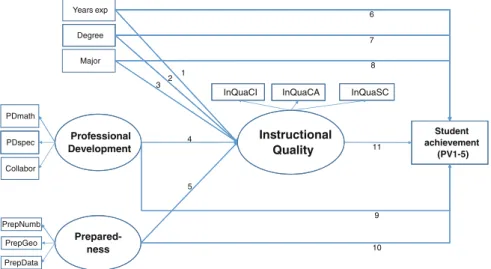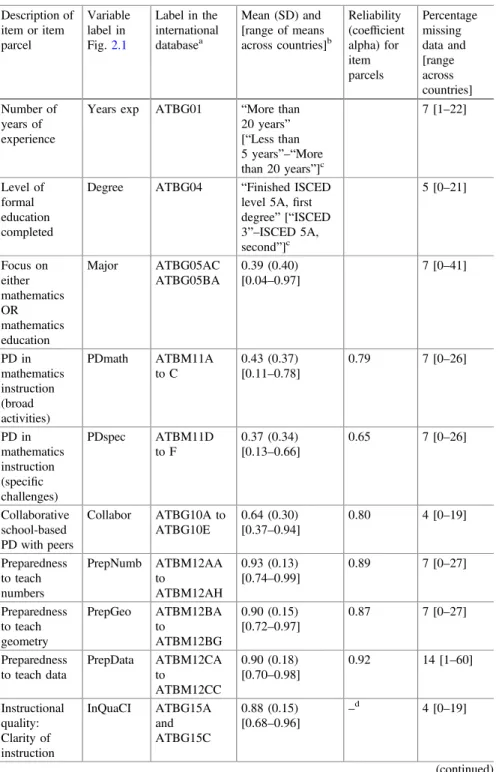The TIMSS study framework describes adaptive policy characteristics at the system, school, classroom, and student levels that are known to influence selected desired educational outcomes, such as achievement in the core curricular domain of mathematics (Mullis et al. 2009). First and foremost, teachers are important (for a summary of the state of research, see e.g. Kyriakides et al. 2009). Most of the reported studies on these relationships, although valuable (for example, Baumert et al. 2010), have been conducted in only one country and usually in a Western country.
In general, meta-analyses support the hypothesis that professional development is positively related to teaching quality and student achievement if activities meet certain quality characteristics (Timperley et al. 2007). In all countries, approximately 40% of teachers had participated in broad or specific PD activities, respectively.

Analysis
Before running the final model, measurement invariance (MI) between countries was tested on the latent constructs in the model. Comparing constructs and their relationships between countries will only yield meaningful results if the instruments measure the same construct in all countries (Van de Vijver and Leung 1997). Because instructional quality and teacher constructs were measured at the class level, we tested for measurement invariance at the school level.
First, configural invariance was examined, meaning that in each country the same items had to be associated with the same latent factors. Metric invariance could be established for all latent constructs included in this model (see Appendix B). In the multigroup model, factor loadings were constrained to be equal across countries, reflecting the metric invariance criterion mentioned above, to ensure comparability.
Indirect relationships at the intermediate level were estimated by multiplying the coefficients for each direct relationship. In the one-group model, the control variables gender and books at home were grand mean centered on the international mean, while all predictors, the mediator InQua, and the dependent variable student achievement in mathematics were group mean centered on the country. . In the multigroup model, the control variables were again grand mean-centered (this now meant the country mean), while the predictors, mediator, and dependent variable remained unchanged.
Relationships were considered significant at within level ifp < 0.05, but given the relatively small number of intermediate level units compared to the number of parameters to be estimated, a more liberal decision rule for significance testing with p < 0.10 was applied for this level.
Results .1 Model Fit
Relation Between Teacher Quality, Instructional Quality and Mathematics Achievement
In nearly half of the countries, PD activities (23 countries) and preparedness (22) were significantly related to InQua with moderately strong effect sizes (β= 0.61 or β= 0.50, respectively), all of which were uniformly positive. While PD activities were related to InQua, especially in European (11 out of 18) and West Asian/Arab (7 out of 12) countries, teachers' sense of preparedness was significantly related to InQua in Southeast Asia (4 out of 7), Latin America ( 2 out of 2) and the Scandinavian (4 out of 5) countries. The relevance of the predictor readiness was also evident through its somewhat weaker but still statistically significant relation to student achievement.
On average, students with higher math achievements in all countries were taught by more experienced teachers, and teachers with more experience also reported higher quality of instruction. However, for both relationships there were also significant effects in the opposite direction for a number of countries, which contradicts the assumed relationship. Teacher education level was not associated with InQua in the pooled dataset, but a significant positive association was found in nine countries.
However, students taught by teachers with relatively higher ISCED levels performed slightly better on the mathematics achievement test, and this positive relationship was also confirmed for twelve countries. This characteristic was most pronounced in the West Asia/Arabia region, albeit with moderate effect sizes. Still, as with the level of teacher education, students in classrooms showing better achievement in mathematics were more often taught by a teacher with a degree in one of these fields in the general international analysis.
In all countries, InQua did not predict fourth-grade student math achievement, and within countries, the predictor was significantly associated with achievement in only three countries.
Discussion
These differences in relationships can affect both the between-country and internal variability in teacher quality and teaching quality, and also the relationship between these concepts and student learning outcomes. The TEDS-M survey showed that teacher education in some countries is nationally standardized, while in other systems teacher education can be highly decentralized (Ingvarson et al. 2013). Furthermore, in some countries teachers are trusted by both the public and their employers, who give them more or less complete autonomy in how they implement the curriculum and teaching.
In other countries, teachers will be firmly entrenched in a hierarchical system, with less freedom to influence curriculum and learning, in the extreme case with defined and detailed lesson plans. Consequently, for all of the teacher quality variables included in this chapter, we observed significantly large variation between countries. A possible consequence of such variation is that, in systems where teachers are fully autonomous individuals with responsibility for the development and implementation of teaching, a relatively large within-country variation in the quality of teaching is possible, whereas systems characterized by teachers equipped with more or less prescriptive lesson plans are likely to have fewer degrees of freedom for some of the components typically involved in teaching quality.
In our models, observed differences in the direct relationships of several variables describing teacher quality with teaching quality may be a reflection of this broader "ecology" of teaching. Taken together, this version illustrates how international studies can use systematic differences in teaching conditions and policies to at least provide examples of how alternative policies work in other settings, although of course such interpretations should be made with caution, as the wider cultural context of education presents a range of potentially highly influential omitted variables. It is reasonable to assume that secondary school teachers in more or less all countries will specialize in one or more subjects.
However, in primary schools, at least in the early years, there will be greater differences between countries in the degree to which teachers have general versus specialized teacher education.
Limitations of the Study
However, this would mean keeping the measures unchanged, which we would not recommend given another limitation of our study; unsatisfactory quality of some measures used. This is primarily a question related to the measure of teaching quality used in this analysis. It is possible that some teachers answered this list of questions without having mathematics instruction in mind, which may cause validity problems (Schlesinger and Jentsch 2016).
There were other related measures that could have been used and are used in the analyzes in other chapters of this book. A set of questions in the mathematics-specific part of the teacher questionnaire also asked teachers to report their teaching activities in mathematics. However, these questions reflect surface characteristics of teaching practice and did not correspond to the theoretical framework of teaching quality used in this book, which is based on current research on teaching quality.
However, given the young age of the students in fourth grade, we chose to rely on the teachers' reports. Improvements in the teaching quality measures to better incorporate recent research in this area (especially the work done by the Klieme group; see for example Decristan et al.2015; Rakoczy et al.2010) appear to be urgently needed. There were other dimensions in the TIMSS questionnaire measuring teacher characteristics that were found to be of relevance to student achievement.
For example, TIMSS did not include measures of teachers' actual knowledge and skills to teach mathematics (see for example, Blömeke et al. 2012; Tatto et al. 2012).
Conclusions and Recommendations
Another important recommendation for future research based on our experience in analyzing the complex relationship between teacher quality, teaching quality, and student outcomes is that future research should invest in developing improved measures of teaching quality. This may reflect not only that students' and teachers' perceptions differ, but also that the measures represent slightly different aspects of the educational activities that take place in the classroom. In general, we would therefore recommend that measures of teaching quality, in line with current practice in the IEA surveys, include both types of sources to develop measures of the quality of teaching activities.
However, the current measures in both the teacher and the student questionnaires fail to fully represent the depth and breadth of the concept of teaching quality. Furthermore, classroom management is an important dimension of teaching quality that is not included in the generic teacher questionnaire. And not least, as already discussed, the construct used in this chapter is based on generic questions, while it would provide more fidelity to the analysis if a measure specific to the quality of the mathematics lessons was applied.
This chapter is distributed under the terms of the Creative Commons Attribution-NonCommercial 4.0 International License (http://creativecommons.org/licenses/by-nc/4.0/), which permits any noncommercial use, duplication, adaptation, distribution, and reproduction in any medium or format, as long as you give appropriate credit to the original author(s) and the source, provide a link to the Creative Commons license and indicate whether changes have been made. Profiles of opportunities to learn in primary teacher education and their relationship to cultural context and outcomes. Longitudinal analysis with student fixed effects. Economics of Education Review Studying Teacher Education: The Report of the AERA Panel on Research and Teacher Education.
Structural equation modeling: a multidisciplinary journal An analysis of teacher education context, structure and quality assurance arrangements in TEDS-M countries: Findings from the IEA teacher education and development study in mathematics (TEDS-M).
